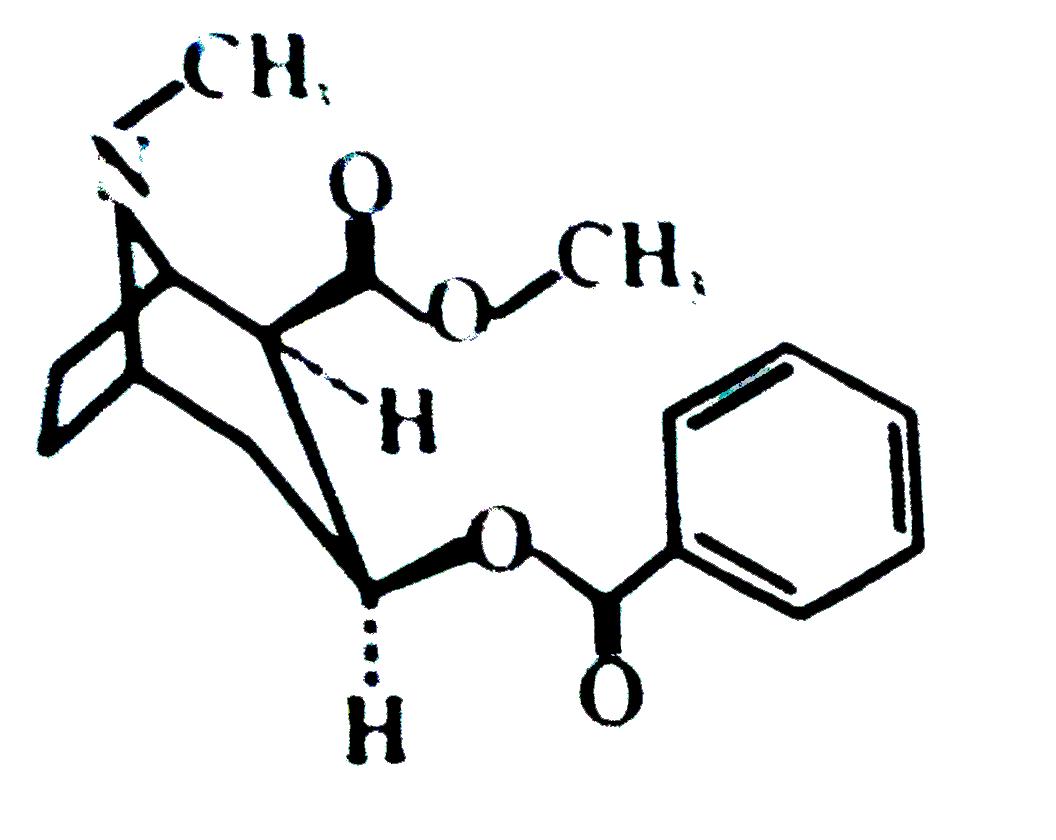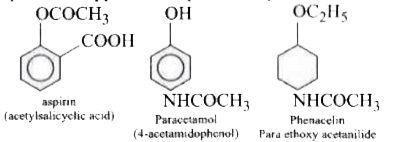Narcotics are chemical substances which produce sleep and unconsciousness. Morphine diacetate is most widely used analgesic . How many double bond equivalents are present in morphine diacetate ?
The correct Answer is:11
To determine the number of double bond equivalents (DBE) in morphine diacetate, we can follow these steps:
Step 1: Identify the molecular formula of morphine diacetate.
Morphine diacetate has the molecular formula C21H23N O5.
Step 2: Use the formula for calculating double bond equivalents.
The formula for calculating double bond equivalents (DBE) is:
DBE=C+1−H2−X2+N2
Where:
- C = number of carbon atoms
- H = number of hydrogen atoms
- X = number of halogen atoms (which is 0 in this case)
- N = number of nitrogen atoms
Step 3: Substitute the values into the formula.
From the molecular formula C21H23N O5:
- C=21
- H=23
- X=0 (no halogens)
- N=1
Now substituting these values into the DBE formula:
DBE=21+1−232−02+12
Step 4: Simplify the equation.
Calculating step-by-step:
1. Calculate 232=11.5
2. Calculate 02=0
3. Calculate 12=0.5
Now substituting these values back into the equation:
DBE=21+1−11.5+0+0.5
DBE=22−11.5+0.5
DBE=22−11=10
Step 5: Conclusion
The number of double bond equivalents in morphine diacetate is 10.
---
Morphine diacetate has the molecular formula C21H23N O5.
The formula for calculating double bond equivalents (DBE) is:
- C = number of carbon atoms
- H = number of hydrogen atoms
- X = number of halogen atoms (which is 0 in this case)
- N = number of nitrogen atoms
From the molecular formula C21H23N O5:
- C=21
- H=23
- X=0 (no halogens)
- N=1
Calculating step-by-step:
2. Calculate 02=0
3. Calculate 12=0.5
The number of double bond equivalents in morphine diacetate is 10.
Similar Questions
Diagram is showing chemical structure of Morphine, which is a natural opiate like codeine. Morphine is a strong analgesic, also has sedative & calming effect. It depresses respiratory centre, BP, heart beat. Constipation is a prominant feature of morphine action. How many ester linkages are present in a morphine moleucle ?

View SolutionHow many B-O-B bond (s) (per molecule) is/are present in compound which is used in Borax bead test ?
View Solution
Knowledge Check
Passage-2
The chemicals used to treat diseases and to reduce the suffering from pain are known as drugs or medicines. The chemicals used in chemotherapy are classified according to their action.
For example antipyretics are medicines used to lower the body temperature in high fever. The examples of antipyretics are para ethoxy acetamide and analgin.

Analgesics are medicines which relieve pain. They are of two types. (i) Narcotics are medicines which relieve pain by producing sleep and unconsciousness. They are morphine, morphine diacetate (heroin) and codeine. They are habit forming (ii) Non narcotic analgesics are not habit forming and do not usually induce sleep. They are aspirin, brufen and butazolidine.
Antiseptics are medicines which kill or prevent the growth of micro-organisms Antiseptics are also used to reduce odours arising out of bacterial decomposition on the surface of the body. They are 2% solution of phenol, dettol (a solution of terpincol and chloro-xylenol) savlon, bithional etc.
Disinfectants are medicines which kill the microorganisms but are not safe for application to living tissues.
Tranquillizers are medicines used to relieve mental tension and an anxiety. They act on the nervous system and induce sleep. They may antidepressants (to elevate mood) such as methedrine and vitalin, sedatives (relieve mental agitation and violence) such as diazopam, seconal, luminal and equanil.
Antibiotics are medicines produced by micro-organisms such as fungi, bacteria and moulds and are used to kill other microorganisms. They are penicillin (Treat sore throat, bronchitis, pneumonia), streptomycin (active against tuberclosis, chloramphenicol treat typhoid, acute fever, urinary infection.
Medicine which is antibiotic is :AAspirinBCalmposeCChloroquineDAmpicillinPassage-2
The chemicals used to treat diseases and to reduce the suffering from pain are known as drugs or medicines. The chemicals used in chemotherapy are classified according to their action.
For example antipyretics are medicines used to lower the body temperature in high fever. The examples of antipyretics are para ethoxy acetamide and analgin.

Analgesics are medicines which relieve pain. They are of two types. (i) Narcotics are medicines which relieve pain by producing sleep and unconsciousness. They are morphine, morphine diacetate (heroin) and codeine. They are habit forming (ii) Non narcotic analgesics are not habit forming and do not usually induce sleep. They are aspirin, brufen and butazolidine.
Antiseptics are medicines which kill or prevent the growth of micro-organisms Antiseptics are also used to reduce odours arising out of bacterial decomposition on the surface of the body. They are 2% solution of phenol, dettol (a solution of terpincol and chloro-xylenol) savlon, bithional etc.
Disinfectants are medicines which kill the microorganisms but are not safe for application to living tissues.
Tranquillizers are medicines used to relieve mental tension and an anxiety. They act on the nervous system and induce sleep. They may antidepressants (to elevate mood) such as methedrine and vitalin, sedatives (relieve mental agitation and violence) such as diazopam, seconal, luminal and equanil.
Antibiotics are medicines produced by micro-organisms such as fungi, bacteria and moulds and are used to kill other microorganisms. They are penicillin (Treat sore throat, bronchitis, pneumonia), streptomycin (active against tuberclosis, chloramphenicol treat typhoid, acute fever, urinary infection.
Which of the following compounds is aspirin ?AAcetyl salicylic acidBMethyl salicylateCPhenyl salicylateDSalicylic acidPassage-2
The chemicals used to treat diseases and to reduce the suffering from pain are known as drugs or medicines. The chemicals used in chemotherapy are classified according to their action.
For example antipyretics are medicines used to lower the body temperature in high fever. The examples of antipyretics are para ethoxy acetamide and analgin.

Analgesics are medicines which relieve pain. They are of two types. (i) Narcotics are medicines which relieve pain by producing sleep and unconsciousness. They are morphine, morphine diacetate (heroin) and codeine. They are habit forming (ii) Non narcotic analgesics are not habit forming and do not usually induce sleep. They are aspirin, brufen and butazolidine.
Antiseptics are medicines which kill or prevent the growth of micro-organisms Antiseptics are also used to reduce odours arising out of bacterial decomposition on the surface of the body. They are 2% solution of phenol, dettol (a solution of terpincol and chloro-xylenol) savlon, bithional etc.
Disinfectants are medicines which kill the microorganisms but are not safe for application to living tissues.
Tranquillizers are medicines used to relieve mental tension and an anxiety. They act on the nervous system and induce sleep. They may antidepressants (to elevate mood) such as methedrine and vitalin, sedatives (relieve mental agitation and violence) such as diazopam, seconal, luminal and equanil.
Antibiotics are medicines produced by micro-organisms such as fungi, bacteria and moulds and are used to kill other microorganisms. They are penicillin (Treat sore throat, bronchitis, pneumonia), streptomycin (active against tuberclosis, chloramphenicol treat typhoid, acute fever, urinary infection.
Antiseptic action of dettol is due to :ACyclohexanolBChloroxylenolCChloramphenicolDNone of these
Passage-2
The chemicals used to treat diseases and to reduce the suffering from pain are known as drugs or medicines. The chemicals used in chemotherapy are classified according to their action.
For example antipyretics are medicines used to lower the body temperature in high fever. The examples of antipyretics are para ethoxy acetamide and analgin.

Analgesics are medicines which relieve pain. They are of two types. (i) Narcotics are medicines which relieve pain by producing sleep and unconsciousness. They are morphine, morphine diacetate (heroin) and codeine. They are habit forming (ii) Non narcotic analgesics are not habit forming and do not usually induce sleep. They are aspirin, brufen and butazolidine.
Antiseptics are medicines which kill or prevent the growth of micro-organisms Antiseptics are also used to reduce odours arising out of bacterial decomposition on the surface of the body. They are 2% solution of phenol, dettol (a solution of terpincol and chloro-xylenol) savlon, bithional etc.
Disinfectants are medicines which kill the microorganisms but are not safe for application to living tissues.
Tranquillizers are medicines used to relieve mental tension and an anxiety. They act on the nervous system and induce sleep. They may antidepressants (to elevate mood) such as methedrine and vitalin, sedatives (relieve mental agitation and violence) such as diazopam, seconal, luminal and equanil.
Antibiotics are medicines produced by micro-organisms such as fungi, bacteria and moulds and are used to kill other microorganisms. They are penicillin (Treat sore throat, bronchitis, pneumonia), streptomycin (active against tuberclosis, chloramphenicol treat typhoid, acute fever, urinary infection.
The drug mathedrine belongs to the class of:
View SolutionPassage-I
Tranquillizers are drugs that reduce emotional instability, tension, fear, anxiety and induce sleep. They are also used in relieving stress, anxiety and irritability. Barbituric acid and its derivatives, known as barbiturates (veronal, amytal, nembutal, luminal) serve as good tranquillizers. Other tranquillizers which are not barbituric acid derivatives are chlordi-azepoxide, equanilmeprobamate, valium (diazepam), etc. Opium alkaloids such as morphine and codeine are powerful analgesics (reduce pain). Morphine is a very potent narcotic analgesic that is known to act on the central nervous system. Antimicrobials are substances that either kill microbes (microbiocidal) or prevent their growth (microbiostatic). These may be either sulpha drugs such as sulphapyridine, sulphadiazine, sulphaguanidine or antibiotics such as erythromycin, tetracycline, chloramphenicol which inhibitor arrest the growth of microbes.
Which of the following are non-narcotic analgesics?
View SolutionPassage-I
Tranquillizers are drugs that reduce emotional instability, tension, fear, anxiety and induce sleep. They are also used in relieving stress, anxiety and irritability. Barbituric acid and its derivatives, known as barbiturates (veronal, amytal, nembutal, luminal) serve as good tranquillizers. Other tranquillizers which are not barbituric acid derivatives are chlordi-azepoxide, equanilmeprobamate, valium (diazepam), etc. Opium alkaloids such as morphine and codeine are powerful analgesics (reduce pain). Morphine is a very potent narcotic analgesic that is known to act on the central nervous system. Antimicrobials are substances that either kill microbes (microbiocidal) or prevent their growth (microbiostatic). These may be either sulpha drugs such as sulphapyridine, sulphadiazine, sulphaguanidine or antibiotics such as erythromycin, tetracycline, chloramphenicol which inhibitor arrest the growth of microbes.
Among the following, the narcotic analgesic is :
View SolutionPassage-I
Tranquillizers are drugs that reduce emotional instability, tension, fear, anxiety and induce sleep. They are also used in relieving stress, anxiety and irritability. Barbituric acid and its derivatives, known as barbiturates (veronal, amytal, nembutal, luminal) serve as good tranquillizers. Other tranquillizers which are not barbituric acid derivatives are chlordi-azepoxide, equanilmeprobamate, valium (diazepam), etc. Opium alkaloids such as morphine and codeine are powerful analgesics (reduce pain). Morphine is a very potent narcotic analgesic that is known to act on the central nervous system. Antimicrobials are substances that either kill microbes (microbiocidal) or prevent their growth (microbiostatic). These may be either sulpha drugs such as sulphapyridine, sulphadiazine, sulphaguanidine or antibiotics such as erythromycin, tetracycline, chloramphenicol which inhibitor arrest the growth of microbes.
Which of the following tranquillizers is a derivative of barbituric acid?
View SolutionPassage-I
Tranquillizers are drugs that reduce emotional instability, tension, fear, anxiety and induce sleep. They are also used in relieving stress, anxiety and irritability. Barbituric acid and its derivatives, known as barbiturates (veronal, amytal, nembutal, luminal) serve as good tranquillizers. Other tranquillizers which are not barbituric acid derivatives are chlordi-azepoxide, equanilmeprobamate, valium (diazepam), etc. Opium alkaloids such as morphine and codeine are powerful analgesics (reduce pain). Morphine is a very potent narcotic analgesic that is known to act on the central nervous system. Antimicrobials are substances that either kill microbes (microbiocidal) or prevent their growth (microbiostatic). These may be either sulpha drugs such as sulphapyridine, sulphadiazine, sulphaguanidine or antibiotics such as erythromycin, tetracycline, chloramphenicol which inhibitor arrest the growth of microbes.
The bactericidal and bacteriostatic antibiotics, respectively, are :
View Solution
